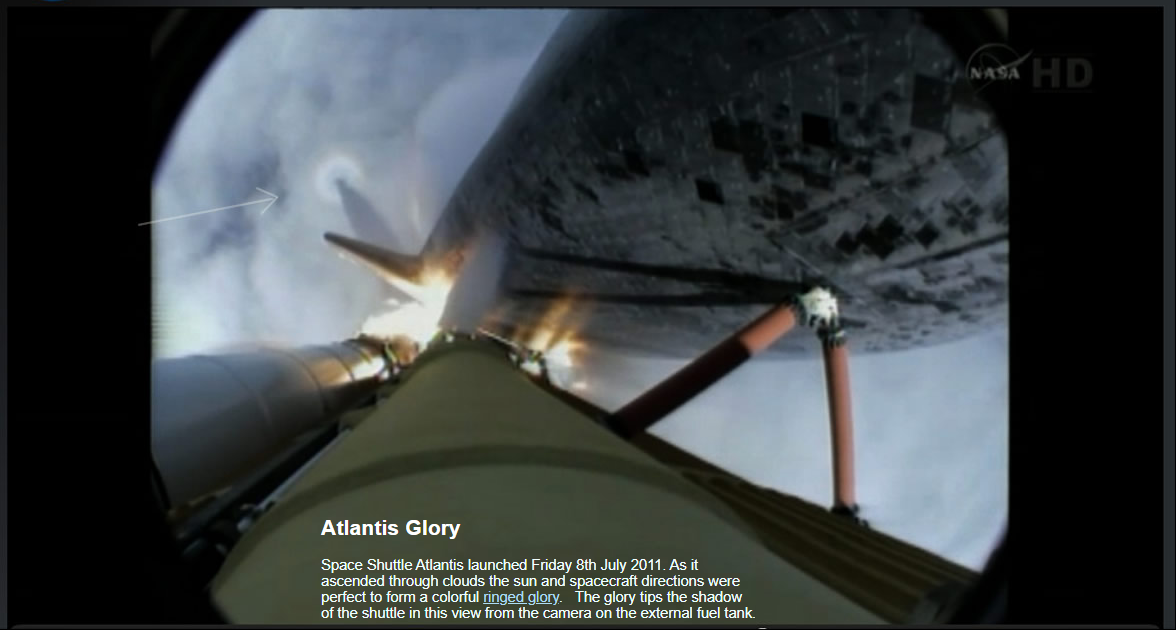OPOD - Atlantis Glory
OPOD - Atlantis Glory: A Rare Atmospheric Phenomenon
On July 8th, 2011, as the Space Shuttle Atlantis embarked on its journey through the clouds, a mesmerizing sight unfolded in the sky. The sun's rays and the spacecraft's trajectory aligned perfectly, giving rise to a captivating atmospheric phenomenon known as the Atlantis Glory. This stunning display of colors adorned the shadow of the shuttle, creating a ringed spectacle that caught the attention of many observers.
One such observer was Rafael Schmall, an avid atmospheric optics enthusiast from Hungary. Alongside a group of friends, Rafael was watching the live NASA TV broadcast of the shuttle launch when he spotted the glory. His keen eye and quick recognition of this rare event allowed others to witness its beauty as well. We extend our gratitude to Rafael for his astute observation, and also to Monika Landy-Gyebnár for alerting us to this incredible phenomenon.
Glories, like the Atlantis Glory, occur when tiny spherical water droplets present in clouds or mist diffract and scatter sunlight in a backward direction. These droplets act as miniature prisms, causing the light to disperse and form concentric rings of colors. While glories are commonly observed around the shadows of airplanes on clouds, this particular instance may be one of the first documented cases of a glory forming around an ascending shuttle.
Unfortunately, this Atlantis Glory may also be the last of its kind. As space shuttle missions have come to an end, opportunities to witness this unique atmospheric phenomenon in conjunction with a shuttle launch have become exceedingly rare. However, the memory of this captivating event serves as a testament to the awe-inspiring beauty that can be found in our atmosphere.
To delve deeper into the mechanics behind glories, it is essential to understand the role of diffraction and scattering. When sunlight encounters tiny water droplets suspended in the air, it undergoes a process called diffraction. This causes the light to change direction as it interacts with the droplets, leading to the creation of a glory. Additionally, the scattering of sunlight by these droplets contributes to the dispersion of colors, resulting in the vibrant rings that make up a glory.
Glories are not limited to just shuttle launches; they can occur in various atmospheric conditions. Here are a few interesting facts about glories:
- Glories are typically observed when the observer is situated between the light source (such as the sun) and the cloud or mist containing the water droplets.
- The size of the water droplets plays a crucial role in determining the size and intensity of the glory. Smaller droplets tend to produce more distinct and vibrant glories.
- Glories are often seen from high altitudes, such as mountaintops or airplanes, where the presence of clouds or mist is more common.
- In addition to water droplets, other types of particles, such as ice crystals or dust, can also contribute to the formation of glories.
- Glories are not exclusive to Earth; they have been observed on other celestial bodies, including Mars and Venus.
The Atlantis Glory serves as a reminder of the intricate and captivating optical phenomena that can occur in our atmosphere. While this particular event may be a rare occurrence, it sparks curiosity about the wonders that await us when we take a closer look at the world above. Whether it be glories, rainbows, or other atmospheric spectacles, the beauty of our skies continues to inspire and amaze us.

Atlantis Glory
Space Shuttle Atlantis launched Friday 8th July 2011. As it ascended through clouds the sun and spacecraft directions were perfect to form a colorful ringed glory. The glory tips the shadow of the shuttle in this view from the camera on the external fuel tank.
The glory was quickly spotted by atmospheric optics observer Rafael Schmall in Hungary who was watching the launch on live NASA TV with a group of friends. Thanks Rafael and also to Monika Landy-Gyebn�r for the alert!
Glories are formed when small spherical water droplets in clouds and mist diffract and scatter sunlight backwards. They are often seen around the shadow of an airplane on clouds but this might well be the first, and sadly also the last, from an ascending shuttle.
Note: this article has been automatically converted from the old site and may not appear as intended. You can find the original article here.
Reference Atmospheric Optics
If you use any of the definitions, information, or data presented on Atmospheric Optics, please copy the link or reference below to properly credit us as the reference source. Thank you!
-
<a href="https://atoptics.co.uk/blog/opod-atlantis-glory/">OPOD - Atlantis Glory</a>
-
"OPOD - Atlantis Glory". Atmospheric Optics. Accessed on December 22, 2024. https://atoptics.co.uk/blog/opod-atlantis-glory/.
-
"OPOD - Atlantis Glory". Atmospheric Optics, https://atoptics.co.uk/blog/opod-atlantis-glory/. Accessed 22 December, 2024
-
OPOD - Atlantis Glory. Atmospheric Optics. Retrieved from https://atoptics.co.uk/blog/opod-atlantis-glory/.